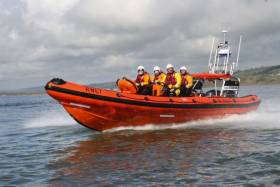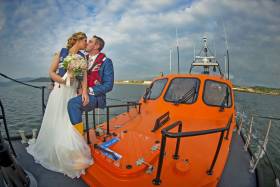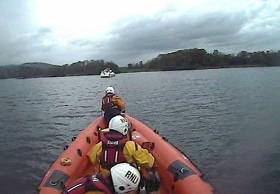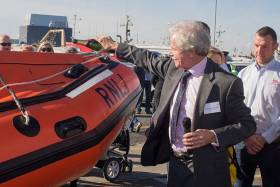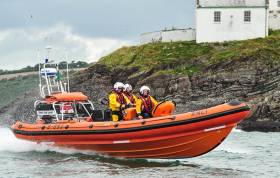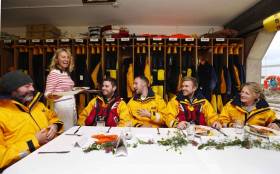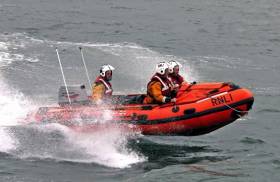Displaying items by tag: RNLI
Youghal Lifeboat Launches To Man Taken Ill On Angling Boat
#RNLI - Youghal RNLI’s volunteer lifeboat crew were tasked yesterday morning (Saturday 15 October) in choppy waters to reports of a man taken ill on board a chartered angling vessel.
At 11.30am the lifeboat launched to the location around a mile and a half off Capel Island, where the casualty had been unconscious for a period and was pale in appearance.
The lifeboat crew proceeded to administer casualty care when they recovered the casualty on board.
An ambulance was also requested and was awaiting the lifeboat on its return to station, where the paramedics checked the casualty over before giving him the all clear.
Commenting on the callout, Youghal RNLI lifeboat Helm John Griffin said: “[The charter vessel operators] did the right thing in contacting us when the man became unwell.
“It’s always better to get an ill person medically checked out if there are any concerns.”
Lough Swilly RNLI Groom’s Wedding Speech Interrupted By Lifeboat Launch
#RNLI - Buncrana man Francy Burns wed his sweetheart, Carndonagh woman Helen McFarland, last Saturday 8 October in a wedding attended by their family, friends and the volunteers with Lough Swilly RNLI.
But it wasn’t all plain sailing, as after the vows were exchanged and Francy took the microphone to make his wedding speech, the lifeboat pagers went off and the volunteer lifeboat crew jumped to their feet and raced out of the room to the callout.
The incident was a reminder to Helen of what she can expect married to a lifeboat volunteer.
However, as Francy was preparing to follow his lifeboat colleagues and head out the door to the callout, the coxswain assured him they had enough crew and he could stay where he was and enjoy the day.
The callout was to a vessel with one person on board which had lost engine power and had been drifting for three hours.
Lough Swilly RNLI launched their new Shannon-class lifeboat and brought the vessel to safety, with the lifeboat crew returning to the wedding reception some hours later.
As the wedding reception was held in the Gateway Hotel, Francy had the perfect view out the window down on the berth from where the lifeboat is launched.
“It was certainly a day of mixed emotions,” said Francy. “I married the most beautiful and amazing woman but when I saw the crew stand up to head out for the lifeboat shout during my speech my first thoughts were to follow them.
“You never know what you are launching to but thankfully it was fairly straightforward. Helen understands how I feel about the lifeboat and she is fully supportive. You never know, I might even persuade her to sign up too.”
Lough Swilly lifeboat volunteer crew member and press officer Joe Joyce added: “The launch sort of added to the whole day. You couldn’t have planned it better.
“Everyone with Lough Swilly RNLI wish Francy and Helen every happiness on their marriage and we will see Francy down at the station for our next shout.”
Courtmacsherry RNLI Lifeboat Rescues 40–foot Sailing Sloop off Kinsale
The Courtmacsherry RNLI All Weather Lifeboat was called out at 12.30pm this afternoon to go to the aid of a 40–foot Sailing Sloop 'in trouble' eight miles off the Old Head of Kinsale in West Cork.
Coxswain Sean O'Farrell and a crew of six launched in response to the Mayday alert from Coastguard and reached the casuality at 1.10 pm. The casualty with two persons on board had lost power in deteriorating conditions at sea and one of the crew person on board the yacht was also reported unwell.
The lifeboat succeeded in transferring its tow rope in difficult conditions to the casualty which was on passage from England to West Cork.
The Lifeboat took the vessel in tow and is heading at low speed to Kinsale.
Conditions at sea this afternoon are very poor with strong winds force 7/8 with very heavy swells. Winds in the area are blowing 35–knots and increasing.
The estimated time of arrival in Kinsale is approx 2.45pm
The RNLI crew are Coxswain Sean O Farrell and volunteer crew members Tadgh McCarthy (Mechanic), Mark Gannon, Ciaran Hurley, Ken Cashman, Mark John Gannon and Dave Philips.
North Dublin actor Brendan Gleeson was at Howth Yacht Club last Thursday (6 Oct 2016) for the annual RNLI Ladies Lunch in aid of Howth RNLI. The sold-out charity event was attended by 150 local ladies and raised over €8,000.
When asked what motivated him to support the RNLI he responded, ‘The RNLI is an incredible organisation. I’m full of admiration for the work that they do. Many years ago I spent time filming on an RNLI lifeboat in South Wales, and it was a privilege to have the opportunity to get to know the crew well. Last year Howth RNLI was the busiest lifeboat station on the coast of Ireland. It’s an honour to be here today, and it’s great to live in Howth among a bunch of heroes’.
Mr. Gleeson, who is one of Ireland’s most prolific actors on stage and screen, is best known for his roles in The Guard, the Harry Potter films and Braveheart, happily mingled with the guests at the sold-out event, and patiently posed for numerous photographs and selfies.
He gave an insightful and thought-provoking speech about the life-saving work of the RNLI, and how the volunteer crewmembers and the people they rescue are so interlinked with local communities. He spoke about the lessening of anxiety and sense of reassurance a community has, knowing that the lifeboat will come to their aid if needed. Mr. Gleeson also mentioned a line from a Seamus Heaney poem about the economy of kindness, and remarked on the dignity the lifeboat crews show to those in their care. He praised the life-saving volunteers and described them as noble, selfless, strong minded and compassionate, who exhibited Navy discipline with maximum efficiency and safety while maintaining a sense of mutual respect and comradeship for their crew mates.
Rose Michael, Howth RNLI Fundraising Chairperson, commented, ‘
We are thrilled to have Brendan here today. He has a deep respect and genuine understanding of the sacrifices and challenges that our volunteer lifeboat crewmembers face every time they are called out on a rescue. We greatly appreciate that he has taken time out of his very busy schedule to be here with us. The funds today raised will go towards the costs of on-going training and crew kits for the lifeboat crew ’.
Lough Derg RNLI Lifeboat launched to assist four people after their 34ft–cruiser ran aground by the Scilly Islands on Lough Derg today. At 1.39pm, the lifeboat launched with helm Ger Egan, Lian Knight and Delia Ho on board. Winds was east-southeasterly, Force 3. Visibility was good.
The lifeboat located the vessel at the junction of Scariff Bay and Parker’s Point at 1.54pm. The four people on board were safe and unharmed and wearing their lifejackets. Once the lifeboat was satisfied the vessel was not holed, it was taken off the rocks and into safe water. The cruiser continued its onward journey once drives and rudder were found to be undamaged and in good working order.
Peter Kennedy, Deputy Launching Authority at Lough Derg RNLI Lifeboat, advises boat users to ‘to bring charts with you and know the areas close to shore and islands marked as un-navigatable, particularly as water levels are low in the lake at the moment’.
The lifeboat returned to Station and was ready for service again at 3pm.
#RNLI - Courtmacsherry RNLI's all-weather lifeboat was called out at 2.45pm yesterday afternoon (Sunday 2 October) as three divers and their support boat sought help as their vessel got into difficulties near Black Head off Kinsale.
The lifeboat was quickly away with a crew of seven and was on scene at 3.15pm to join Kinsale RNLI and the Irish Coast Guard boat from Oysterhaven.
As the divers and their boat were being brought back to shore, another call came from Valentia Radio of an injured crew person on board a sailing vessel off Kinsale Harbour.
Both the Kinsale and Courtmacsherry lifeboats assisted in the transfer of the female casualty to Kinsale Pier, where an ambulance was awaiting to take her to Cork University Hospital.
Conditions at sea today deteriorated from early afternoon with a Force 5 to 6 wind and a strong sea swell.
The cew on the Courtmacsherry lifeboat yesterday were coxswain Sean O'Farrell, mechanic Stewart Russell, Ciaran Hurley, Mark Gannon, Dara Gannon, Dean Hennessey and Evan O'Sullivan.
Lifeboat crew, station management, fundraisers and supporters of Howth RNLI were joined by members of the public yesterday (Sunday 2 October) to officially name the North Dublin lifeboat station’s newest lifeboat Aideen Cresswell, in memory of the incredible woman who funded it. The ceremony took place in the sunshine in Howth Harbour where the public saw up-close Howth RNLI’s newest lifeboat as it was officially named by Mrs Cresswell’s nephew Seymour, in the maritime tradition by pouring champagne over its bow.
As Afloat.ie previously reported, Mrs Aideen Cresswell (nee Stokes) whose generous bequest funded the €71,000 lifeboat was born in London in 1921 and later came to live in The Baily, Howth. At a young age she met her husband John Cresswell at an RNLI ball and they spent their honeymoon on board a yacht sailing from Dublin to Dunmore East. Mrs Cresswell’s nephew Seymour remembered his aunt during his speech, whom he described as ‘a rebel; feisty and a free spirit’. He spoke of her lifelong support of the RNLI and her affinity for the sea. She passed away in 2011after a short illness in her ninety-first year and was married to John for sixty-seven years.
RNLI Vice-President and member of the Irish Council Mr. Peter Killen accepted the lifeboat into the care of the RNLI before passing it on to Howth lifeboat station. The ceremony was opened by Howth RNLI Chairman Russell Rafter and the Vote of Thanks was given by Mrs Rose Michael in her role as Chairperson of the Fundraising branch. Rose also presented Mrs Cresswell’s two nephews with framed photographs of the new lifeboat which were signed by the crew.
On accepting the lifeboat into the care of Howth RNLI, Colm Newport, the station’s Lifeboat Operations Manager said: ‘I accept with great pride this lifeboat Aideen Cresswell to Howth Lifeboat Station. Aideen’s legacy provides the lifeboat that will be of service to all who earn their living or derive pleasure from the sea and coastline in our area. Since we received our new lifeboat this summer she has been called out on service nine times.’
Following the ceremony the new lifeboat was launched into Howth Harbour to the accompaniment of a lone piper. Howth lifeboat station was established before 1825 and taken over by the RNLI in 1862. During its tenure Howth’ s volunteer lifeboat crew have been awarded eleven medals for Gallantry: seven silver and four bronze. The station also operates an all-weather Trent class lifeboat.
The inshore lifeboat remains the workhorse of the RNLI as it has for nearly 50 years. The inflatable rescue craft is highly manoeuvrable and specifically suited to surf, shallow water and confined locations – often working close to cliffs, among rocks or even in caves.
The equipment on board the new lifeboat includes a VHF radio, night-vision technology, and first-aid kit including oxygen. It has a maximum speed of 25 knots and can carry three crew members and five survivors.
The Aideen Cresswell’s predecessor was on service at the station from 2006 to 2016. During its time at the station it was launched 260 times, rescued 288 people, saving 19 lives. It spent 167 hours on service.
RIB Hits Cork Harbour Navigation Buoy, Crosshaven RNLI Lifeboat Assists Casualty At City Marina
Crosshaven RNLI lifeboat in Cork Harbour was requested to launch yesterday evening at 8.49pm after a report of a 9m RIB (Rigid Inflatable Boat) with two people on board hit a navigation Buoy near Tivoli in Cork City.
Reports also were given that one person was injured.
The volunteer crew made best safe speed on the 20 minute journey to the City. New information received en route stated the damaged RIB had managed to journey under its own power to Cork City marina, but was still requesting first aid help.
On arrival at the City Marina, the RNLI crew assessed the casualty who was complaining of chest injuries and administered first aid until the emergency ambulance arrived and conveyed the casualty to hospital.
The lifeboat then escorted the damaged RIB on its return journey to Crosshaven and assisted in putting the vessel alongside
The lifeboat arrived back at the station in Crosshaven at 10.50pm, where it was refueled, washed down and declared ready for service once more at 11.30pm
Chef Clodagh McKenna Serves Fish Supper Treat For Howth Lifeboat Crew
#RNLI - Celebrated chef, food writer and television personality Clodagh McKenna recently visited Howth Lifeboat Station, where she treated the volunteer crew to a delicious seafood supper.
McKenna’s visit marks the countdown to the RNLI’s upcoming foodie fundraiser Fish Supper, for which the charity is encouraging people across Ireland to host a fish-themed dinner between 14–16 October to raise funds to help save lives at sea.
The Clodagh’s Irish Kitchen author served a three-course meal for the lifeboat crew, starting with fresh Dingle crab cakes with Irish heirloom tomatoes and fennel aioli.
The main dish was pan-fried sea bass with hazelnut butter with dill potato dumplings and autumn vegetable salad. For dessert, the crew were treated to McKenna’s signature chocolate Guinness cake.
“It was an absolute pleasure to cook for the Howth volunteer lifeboat crew,” said McKenna. “My grandpop and uncle were both fishermen, so the work of the RNLI is very close to my heart.
“When I was filming my series Fresh From the Sea for RTÉ, I was lucky enough to get to see the work of the RNLI first hand. Please sign up to make a Fish Supper and help the courageous crews save more lives at sea.”
Last year, RNLI volunteer crew members across Ireland and the UK missed nearly 7,000 evening meals with their loved ones to brave cold, angry and often dangerous waters to save lives.
Fish Supper aims to highlight the disrupted dinners RNLI crew experience day-in-day-out, and the commitment shown not only by them but their families, who often have an empty place at the dinner table.
RNLI volunteers give up their time, comfort and often home cooked meals to respond immediately when the pagers go off.
“Our lifeboat crew here in Howth and indeed across Ireland are prepared to drop everything and respond to a call out at a moment’s notice,” said Howth RNLI mechanic Ian Sheridan.
“Our lifesaving work is essential and often challenging and dangerous. As volunteers, we are extremely grateful to people who donate so generously and host fundraising events such as Fish Supper to enable us to do what we do.”
To request your free fundraising pack and receive more information, visit RNLI.org/FishSupper where you’ll also find recipes, party game ideas and place name cards to help the evening go well.
Last year, RNLI lifeboat crews across 45 stations in Ireland had 1,098 lifeboat launches, bringing 1,244 people to safety. Of all recorded launches, 416 were carried out in the hours of darkness.
Fethard Lifeboat Assists Man After Pleasure Craft Breakdown
#RNLI - Fethard RNLI launched yesterday afternoon (Thursday 29 September) to assist a man whose pleasure craft broke down off the Wexford coast.
The volunteer lifeboat crew were requested to launch their inshore lifeboat at 4.07pm following a report that a 21ft pleasure boat, with one onboard, had sustained engine failure in an area known locally as the Horseshoe.
Helmed by Eoin Bird and with crew members Patrick Byrne and Damian Murphy onboard, the lifeboat made its way to the scene 1.5 nautical miles from Fethard Harbour. Weather conditions at the time were described as good with a Force 5 westerly but sheltered wind blowing.
Once on scene, the lifeboat crew observed that the boat had washed up on the sand due to the tide.
The crew beached their D-class lifeboat before working to set up a towline with the casualty vessel. Once this was set up, the lifeboat proceeded to tow the pleasure boat back to Fethard Harbour, where it arrived at 5.10pm.
Speaking following the callout, Fethard RNLI deputy launching authority Hugh Burke said: “The area in which the man got into difficulty today is one where our lifeboat crew has to train regularly due to the sandbanks and sandbars which change regularly with each gale of wind.
“We would always encourage anyone planning a boat trip to always respect the water – make sure you wear a life jacket and carry a means of communication should you get into trouble and need to make contact.”


























